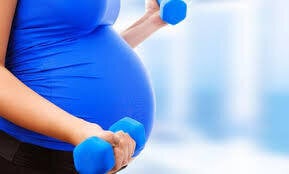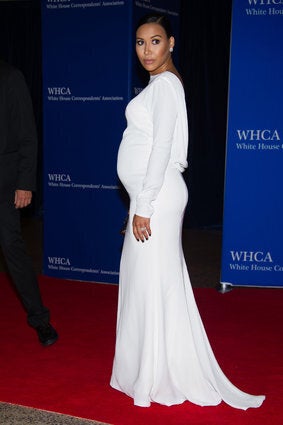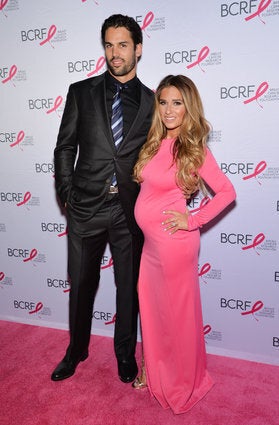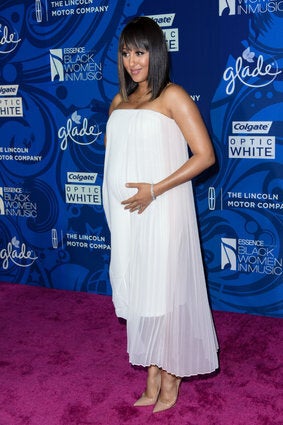

We know that exercising during pregnancy is good for both mom and baby -- from boosting your energy and sleeping better, to reducing the risk of gestational diabetes and joint pain. Still, the current pregnancy exercise guidelines are vague at best. "Warm up, keep your heart rate under 140 BPM, stay off your back, avoid dangerous sports and stay hydrated" pretty much sums it up.
I remember taking my first pre and postnatal certification course years ago, and the guidelines were just as generic. I was disappointed as a fitness professional, especially one yet to have kids. There had to be more guidance. Pregnant women in gyms were uncertain as to what was safe that they often quit working out all together. Those who did persevere with their regular classes often received no direction other than "take it easy" while trying to self-modify the group exercises.
So naturally I nerded out and learned everything possible about pre and postnatal fitness. From interviewing PhDs in women's health and becoming a Labour Doula, to taking three different courses on diastasis recti, a.k.a. 'mummy tummy'; the separated connective tissue that leaves many postpartum moms with flabby bellies and a compromised core.
The search for a better pregnancy workout led me to discover pelvic floor physiotherapy. It turns out that a functional pelvic floor is pretty much the most important thing ever. Want to prevent pregnancy back pain and reduce your risk of mummy tummy? Want your body to bounce back after you deliver your baby? Want to avoid organ prolapse and incontinence? It comes down to keeping your pelvic floor -- the base of your torso and centre of your stability -- strong. It comes down to your "kegels," and whether you're doing them right (hint: most aren't).
Here's how pregnancy and the pelvic floor works: picture a bowling ball (your baby) bouncing on a trampoline (your pelvic floor). As the ball gets bigger and heavier, your trampoline needs to keep up with demands. We need to ensure the trampoline is strong enough (not too taut, not too lax) to support things properly. Unfortunately, telling women to do their kegels just doesn't cut it.
These exercises were originally created and taught by Dr. Arnold Kegel in the 1940s during gynecological exams. Most women today are merely guessing whether they're doing kegels correctly, and many are forgetting to release. They're just "holding their pee." (Picture someone with very tense, elevated shoulders holding heavy weights over their head at the gym for minutes on end. Bad idea. Tension gets worse. Tension→ dysfunction → weakness.)
Pregnancy exercise must include instruction on proper pelvic floor engagement and postural alignment, coupled with key strengthening and stretching exercises to assist women through pregnancy, labour/delivery and postpartum recovery. Here's the breakdown:
First Trimester: 1 - 13 weeks
Issues: Your body is building the placenta and hormone levels are doubling each day. Mood swings and fatigue are common. Blood pressure is lower than usual due to vasodilation from the new hormone relaxin, which can lead to increased heart rate and dizziness on exertion.
Goal: Connect with your deepest layer of abdominals (the transversus abdominis) before this muscle stretches out from the growing baby in the second trimester. Learn how to breathe using your diaphragm to help manage hormonal related dizziness and nausea.
Second Trimester: 14 - 26 weeks
Issues: Your hormone levels have stabilized now that the placenta is built. Blood pressure has normalized and energy levels have improved so this is the best time for introducing more intensity to workouts. The growing baby has started to stretch the transversus muscle so it may feel more challenging to connect with the deep layer of abdominals.
Goal: Add new dynamic movements to build on the diaphragmatic breathing learned in Trimester 1. Focus on preventing postural changes as the belly grows. Strengthen pelvic floor and outer hips for balance and stability, and stretch shortening muscles to maintain alignment.
Third Trimester: 27 - 40 weeks
Issues: In this final stage of pregnancy, your body is coping with the greatest amount of intra-abdominal pressure from the large baby. The strain on the abdominal wall and pelvic floor is significant. Postural compensations due to this increased load can create discomfort and fatigue.
Goal: Practice releasing the pelvic floor (no more kegel lifting) in preparation for delivery. Prevent mummy tummy or diastasis recti (overstretched abdominal tissue) by avoiding front loaded positions like plank or quadruped to minimize forward pressure on the abdominal wall. Focus on both stretching and strengthening to manage discomfort in this final stage of pregnancy.
Here's an explanation of mummy tummy with Dr. Sinead Dufour
All pregnant women will benefit from following these trimester specific guidelines, regardless of their prior fitness level. Each trimester of pregnancy presents different challenges and calls for a different workout focus.
Make it a priority to take care of yourself. Try coming from a place of self-kindness. Too often the message we internalize around pregnancy is one of self-criticism and competition to "get your body back fast." This mindset leads to negative self-talk and frantic stroller baby bootcamp injuries. We either give up with a defeatist attitude and do nothing, or punish our bodies back into our skinny jeans. Either way, our body suffers.
Let's find some middle ground and work not only on that pelvic floor abdominal connection, but on that positive mind body one too.
ALSO ON HUFFPOST:
















